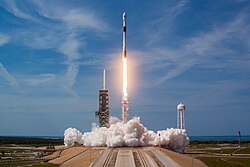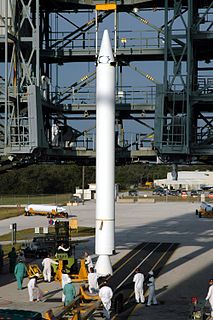
A booster rocket is either the first stage of a multistage launch vehicle, or else a shorter-burning rocket used in parallel with longer-burning sustainer rockets to augment the space vehicle's takeoff thrust and payload capability. Boosters are traditionally necessary to launch spacecraft into low Earth orbit, and are especially important for a space vehicle to go beyond Earth orbit. The booster is dropped to fall back to Earth once its fuel is expended, a point known as booster engine cut-off (BECO). The rest of the launch vehicle continues flight with its core or upper-stage engines. The booster may be recovered and reused, as was the case of the Space Shuttle.
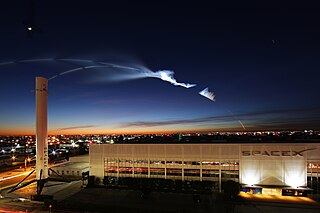
Space Exploration Technologies Corp., trading as SpaceX, is an American aerospace manufacturer and space transportation services company headquartered in Hawthorne, California. It was founded in 2002 by Elon Musk with the goal of reducing space transportation costs to enable the colonization of Mars. SpaceX has developed several launch vehicles, the Starlink satellite constellation, and the Dragon spacecraft.

Falcon 9 is a partially reusable two-stage-to-orbit medium-lift launch vehicle designed and manufactured by SpaceX in the United States. It is powered by Merlin engines, also developed by SpaceX, burning cryogenic liquid oxygen and rocket-grade kerosene (RP-1) as propellants. Its name is derived from the fictional Star Wars spacecraft, the Millennium Falcon, and the nine Merlin engines of the rocket's first stage. The rocket evolved with versions v1.0 (2010–2013), v1.1 (2013–2016), v1.2 "Full Thrust" (2015–present), including the Block 5 Full Thrust variant, flying since May 2018. Unlike most rockets, which are expendable launch systems, since the introduction of the Full Thrust version, Falcon 9 is partially reusable, with the first stage capable of re-entering the atmosphere and landing vertically after separating from the second stage. This feat was achieved for the first time on flight 20 with the v1.2 version in December 2015.

The SpaceX Dragon, also known as Dragon 1 or Cargo Dragon, was a class of reusable cargo spacecraft developed by SpaceX, an American private space transportation company. Dragon was launched into orbit by the company's Falcon 9 launch vehicle to resupply the International Space Station (ISS). It is now superseded by SpaceX Dragon 2.

Soyuz-2 is the 21st-century version of the Russian Soyuz rocket. In its basic form, it is a three-stage carrier rocket for placing payloads into low Earth orbit. Compared to the previous versions of the Soyuz, the first-stage boosters and two core stages feature uprated engines with improved injection systems. Digital flight control and telemetry systems allow the rocket to be launched from a fixed launch platform, whereas the launch platforms for earlier Soyuz rockets had to be rotated as the rocket could not perform a roll to change its heading in flight.
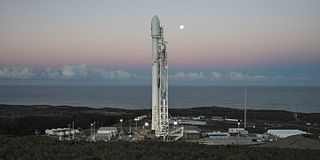
Space Launch Complex 4 (SLC-4) is a launch and landing site at Vandenberg Air Force Base with two pads, both of which are used by SpaceX for Falcon 9 launch operations; operating as Landing Zone 4 (LZ-4) for SpaceX landings.

The Falcon Heavy is a partially reusable heavy-lift launch vehicle designed and manufactured by SpaceX. It is derived from the Falcon 9 vehicle and consists of a strengthened Falcon 9 first stage as the center core with two additional Falcon 9-like first stages as strap-on boosters. The Falcon Heavy has the highest payload capacity of any currently operational launch vehicle, the second-highest capacity of any rocket ever to reach orbit, trailing the Saturn V, and the third-highest capacity of any orbital-class rocket ever launched successfully.

Notable spaceflight activities in 2017 included the maiden flight of India's Geosynchronous Satellite Launch Vehicle Mark III on 5 June and the first suborbital test of Rocket Lab's Electron rocket, inaugurating the Mahia spaceport in New Zealand. The rocket is named for its innovative Rutherford engine which feeds propellants via battery-powered electric motors instead of the usual gas generator and turbopumps.
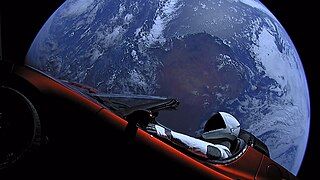
This article lists achieved spaceflight events in 2018. For the first time since 1990, more than 100 orbital launches were performed globally.

The SpaceX reusable launch system development program is a privately funded program to develop a set of new technologies for an orbital launch system that may be reused many times in a manner similar to the reusability of aircraft. SpaceX has been developing the technologies over several years to facilitate full and rapid reusability of space launch vehicles. The project's long-term objectives include returning a launch vehicle first stage to the launch site in minutes and to return a second stage to the launch pad following orbital realignment with the launch site and atmospheric reentry in up to 24 hours. SpaceX's long term goal is that both stages of their orbital launch vehicle will be designed to allow reuse a few hours after return.

Falcon 9 v1.1 was the second version of SpaceX's Falcon 9 orbital launch vehicle. The rocket was developed in 2011–2013, made its maiden launch in September 2013, and its final flight in January 2016. The Falcon 9 rocket was fully designed, manufactured, and operated by SpaceX. Following the second Commercial Resupply Services (CRS) launch, the initial version Falcon 9 v1.0 was retired from use and replaced by the v1.1 version.

The Falcon 9 first-stage landing tests were a series of controlled-descent flight tests conducted by SpaceX between 2013 and 2016. Since 2017, the first stage of Falcon 9 missions has been routinely landed if the rocket performance allowed it, and if SpaceX chose to recover the stage.
A floating landing platform is a large marine floating structure used to land launch vehicle booster stages.

An autonomous spaceport drone ship (ASDS) is an ocean-going vessel derived from a deck barge, outfitted with station-keeping engines and a large landing platform and is controlled by an autonomous robot. Construction of such ships was commissioned by aerospace company SpaceX to allow for recovery of rocket first-stages at sea for missions which do not carry enough fuel to return to the launch site after boosting spacecraft onto an orbital or transplanetary trajectory.

Falcon 9 Full Thrust is a partially reusable medium-lift launch vehicle, designed and manufactured by SpaceX. Designed in 2014–2015, Falcon 9 Full Thrust began launch operations in December 2015. As of 1 July 2020 Falcon 9 Full Thrust had performed 68 launches.
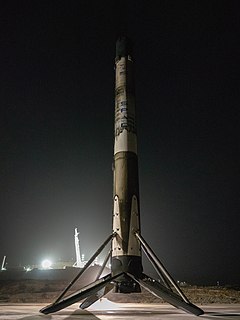
Falcon 9 booster B1048 was a reusable orbital-class Block 5 Falcon 9 first-stage booster manufactured by SpaceX. B1048 was the third Falcon 9 Block 5 to fly and the second Block 5 booster to re-fly. It became the second orbital-class booster to fly a third time and is the first booster ever to be launched five times. B1048 service came to an end on its fifth flight when an engine shut down prematurely on launch. Whilst the primary mission was unaffected and the Starlink payload deployed successfully, B1048 was unable to land. SpaceX CEO Elon Musk announced an investigation was underway following the launch anomaly.

Falcon 9 Block 5 is a two-stage-to-orbit medium lift launch vehicle designed and manufactured domestically in the United States by SpaceX. It is the fifth version of Falcon 9 Full Thrust, powered by SpaceX Merlin engines burning liquid oxygen (LOX) and rocket-grade kerosene (RP-1) propellants.

Falcon 9 booster B1056 was a reusable Falcon 9 Block 5 first-stage booster manufactured by SpaceX. The booster was the fourth Falcon 9 to fly four times and broke a turnaround record for an orbital class booster on its fourth flight. The booster's service came to an end on its fourth flight following a landing failure on a Starlink flight.

